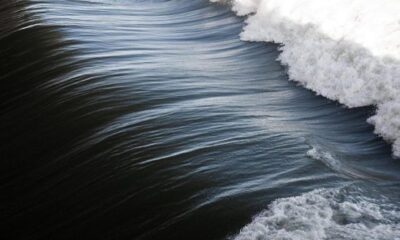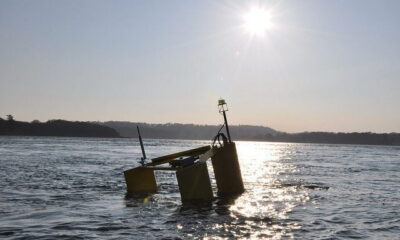

Energy
Tidal energy: “potential to provide a source of clean green energy to the UK”
Matthew Woodhatch of Groundsure writes in their blog: “Tidal energy has the potential to provide a reliable and predictable source of clean green energy to the UK.” Republished with the kind permission of Groundsure.
The world’s tides are controlled by a complex but predictable relationship between the position of the moon and the sun producing a gravitational pull on the Earth’s oceans, combined with the effect of the wind and ocean currents. Therefore, sites which are prone to large and powerful tidal variations can potentially generate vast amounts of energy.
In July 2011, the UK government released its Renewable Energy Roadmap report setting out the future plans of the UK’s renewable energy strategy. Within the report, the section on marine energy highlighted a future £20m worth of government funding which would be put into new innovation and commissioning of marine energy testing facilities and the National Renewable Energy Centre (Na REC). With a potential of 300MW being deployed to the grid by 2020, securing investment for projects and infrastructure, along with consultation on strategic environmental assessments and policy making, was a priority outcome of the report.
Similar to wind turbines, tidal turbines consist mainly of a tower structure connected to the sea floor with a number of turbines attached underneath the water. Electricity is generated as tidal water passes through the turbine blades causing them to rotate. The energy generated is then sent through a system of substations and underwater cables and fed into the national grid.
Tidal turbines have the potential to mitigate some of the argued negative aspects of offshore wind turbines. A prominent objection to offshore wind farms is the visual impact on the Seascape highlighted recently which the objections raised to the Navitus Bay wind farm located off the Dorset coast. Local Conservative MPs and councils expressed concern that the project would “industrialise” precious views and have “catastrophic” consequences for thousands of tourism-related jobs. As a result, government ministers have recently vetoed the application for the Navitus Bay wind farm development.
Where have we come from?
One of the first tidal turbine installations in the UK is the SeaGen S project located at Strangford Lough, Northern Ireland, which was installed in 2008. The SeaGen S 1.2MW devices consist of a twin axial-flow turbine supported on a structure which has the ability to raise the turbines out of the water for maintenance. Since it was commissioned the SeaGen S turbine has generated over 8GWH of electricity. It has since been upgraded with 20m rotors, increasing its output to 2MW, generating power for 2,000 homes.
Where are we going?
Swansea Tidal Lagoon
In June 2015, a tidal lagoon project to be located in Swansea Bay was granted development consent by the Secretary of State. The Tidal Bay Lagoon project (TLP) consists of a large 9.5km breakwater creating an 11.5 km2 lagoon, with a sluice gate housing 26 turbines. When the tide rises, the sluice gates open, allowing water to pass through the turbines and into the lagoon. As the tide falls the sluices are closed while the sea level drops, then the sluice gates are opened and water passes back through the turbines into the sea. This gives the potential to generate electricity at four intervals during a 24 hour period. The lagoon would generate 320MW of electricity 14 hours a day for 120 years, producing enough electricity to power 155,000 homes, equivalent to 90% of Swansea Bay’s domestic energy use8.
The lagoon will also incorporate water sports and leisure facilities, an amenity not just for local people but capable of hosting international sporting events. A visitor centre, educational facilities, art work, marine-culture and conservation programmes have all been included in the lagoon’s design, creating a unique tourist attraction in its own right. A Chinese construction company has been contracted to the build the project, and a core aim is to create a significant local economic benefit to Swansea Bay. The project hopes to start construction in late 2016 and could be operational by the end of the decade.
Kepler Energy Project
Another tidal energy project which utilises a new revolutionary turbine design is the Kepler energy project being proposed in the Bristol Channel. Instead of using a lagoon and turbine gate system, Kepler Energy propose to use a Transverse Horizontal Axis Water Turbine (THAWT), designed loosely on the principles of old water wheels. The turbines are connected together to form a long fence-type structure with the turbines placed in-between connecting towers. The new THAWT design enables a significant quantity of power to be generated, even in shallow, low velocity tidal zones.
The project proposes to construct a 1km turbine fence at an estimated cost of £143m and to be potentially operational by 2020/2110. The 1km turbine fence has the potential to generate an estimated 30MW, enough to power 30,000 UK homes a year. To increase the power output of one site, additional fences can be easily added to the fence structure which can generate extra power once installed.
Bigger picture?
The UK needs to meet its renewable energy goal of 15% of total production by 2020 and with significant objections raised to onshore and offshore wind farms, tidal energy farms could be the answer to meet the 5% expected shortfall in renewable energy production. Given that the vast majority of a tidal energy farm’s infrastructure is located underwater, the visual impact on the landscape in comparison to wind turbine farms would be significantly less. Tidal power could be one answer to securing future renewable energy production whilst also preserving the natural appearance of our shore and coast line.


 Environment10 months ago
Environment10 months agoAre Polymer Banknotes: an Eco-Friendly Trend or a Groundswell?

 Environment12 months ago
Environment12 months agoEco-Friendly Home Improvements: Top 7 Upgrades for 2025

 Features9 months ago
Features9 months agoEco-Friendly Cryptocurrencies: Sustainable Investment Choices

 Features11 months ago
Features11 months agoEco-Friendly Crypto Traders Must Find the Right Exchange






























